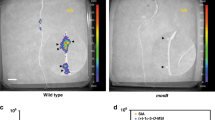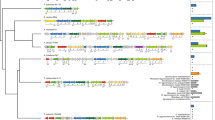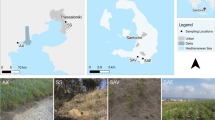Abstract
The ability to catabolize distinct nutrients produced by a plant may be a factor in the successful colonization of that host by a bacterium when in competition with other rhizosphere microorganisms. We tested this hypothesis by examining the influence of a novel substrate produced by a transgenic plant on root colonization by near-isogenic bacteria, differing only in their ability to use the resource. When inoculated alone, both bacteria colonized the roots of the normal and transgenic plants with equal kinetics and to indistinguishable levels. When the two bacteria were coinoculated, the catabolizer reached a population density significantly higher than that of the noncatabolizer on the roots of the resource-producing plant. No such advantage was observed on the roots of normal plants. These results support the theory that resources produced and exuded by a plant host can confer a selective advantage to microorganisms that use the substrate.
This is a preview of subscription content, access via your institution
Access options
Subscribe to this journal
Receive 12 print issues and online access
$209.00 per year
only $17.42 per issue
Buy this article
- Purchase on Springer Link
- Instant access to full article PDF
Prices may be subject to local taxes which are calculated during checkout
Similar content being viewed by others
References
O'Connell, K.P., Goodman, R.M., and Handelsman, J. 1996. Engineering the rhizosphere: expression of bias. TIBTECH 14: 83–88.
Dowling, D.N. and Broughton, W.J. 1986. Competition of nodulation of legumes. Annu. Rev. Microbiol. 40: 131–157.
van Egeraat, A.W.S.M. 1975. The possible role of homoserine in the development of Rhizobium leguminosarum in the rhizosphere of pea seedlings. Plant and Soil 42: 381–386.
Johnston, A.W.B. et al. 1988. Genetic factors affecting host range in Rhizobium Leguminosarum. pp. 374–384, in: Molecular genetics of plant-microbe interactions. Palacios, R. and Verma, D.P. (eds). APS Press, St. Paul, MM.
Zambryski, P.C. 1988. Basic processes underlying Agrobacterium mediated DMA transfer to plant cells. Annu. Rev. Genet. 22: 1–30.
Dessaux, Y., Petit, A., and Tempé, J., 1992. Opines in Agrobacterium. Biology. pp. 109–136 in: Molecular signalling in plant-microbe communication. Verma, D.P. (ed). CRC Press, Boca Baton, FL.
Tempé, J., Guyon, P., Tepfer, D.A., and Petit, A. 1979. The role of opines in the ecology of the Ti plasmids of Agrobacterium, pp. 353–363 in Plasmids of medical, environmental and commercial importance. Timmis, K.N. and Pülher, A. (eds). Elsevier North Holland Biomedical Press, Amsterdam.
Guyon, P., Petit, A., Tempé, J., and Dessaux, Y. 1993. Transformed plants producing opines specifically promote growth of opine-degrading agrobacteria. Mol. Plant-Microbe Interact. 6: 92–98.
Scott, D.B., Wilson, R., Shaw, J., Petit, A., and Tempé, J. 1987. Biosynthesis and degradation of nodule-specific Rhizobium loti compounds in Lotus nodules. J. Bacteriol. 169: 278–282.
Murphy, P.J. and Saint, C.P. 1992. Rhizopines in the legume-rhizobium symbiosis, pp. 377—390 in Molecular signalling in plant-microbe communication. Verma, D.P. (ed). CRC Press, Boca Raton, FL.
Tepfer, D. et al. 1988. A plasmid of Rhizobium meliloti 41 encodes catabolism of two compounds from root exudates of Calystegium sepium. J. Bacteriol. 170: 1153–1161.
Rossbach, S., Rasul, G., Schneider, M., Eardly, B., and de Bruijn, F.J. 1995. Structural and functional conservation of the rhizopine catabolism (moc) locus is limited to selected Rhizobium meliloti strains and unrelated to their geographical origin. Mol. Plant-Microbe Interact. 4: 549–559.
Murphy, J.P., Wexler, W., Grzemski, W., Rao, J.P., and Gordon, D. 1995. Rhizopines—their role in symbiotic and competition. Soil Biol. Biochem. 27: 525–529.
Oger, P., Petit, A., and Dessaux, Y. 1997. Genetically engineered plants producing opines alter their biological environment. Nature Biotechnology 15: 369–372.
Wilson, M., Savka, M.A., Hwang, I., Farrand, S.K., and Lindow, S.E. 1995. Altered epiphytic colonization of mannityl opine-producing transgenic tobacco plants by a mannityl opine-catabolizing strain of Pseudomonas syringae. Appl. Environ. Microbiol. 61: 2151–2158.
Wilson, M. and Lindow, S.E. 1994. Coexistence among epiphytic bacterial populations mediated through nutritional resource partitioning. Appl. Environ. Microbiol. 60: 4468–4477.
Bowen, G.D. and Rovira, A.D. 1976. Microbial colonization of plant roots. Annu. Rev. Phytopathol. 14: 121–144.
Lynch, J.M. and Whipps, J.M. 1990. Substrate flow in the rhizosphere. Plant and Soil 129: 1–10.
Lindow, S.E. 1987. Competitive exclusion of epiphytic bacteria by Ice–Pseudomonas syringae mutants. Appl. Environ. Microbiol. 53: 2520–2527.
Savka, M.A. and Farrand, S.K. 1992. Mannityl opine accumulation and exudation by transgenic tobacco. Pl. Physiol. 98: 784–789.
Ellis, J.G., Ryder, M.H., and Tate, M.E. 1984. Agrobacterium tumefaciens TR-DNA encodes a pathway for agropine biosynthesis. Mol. Gen. Genet. 181: 466–473.
Tate, M.E. et al. 1982. Agropine: a revised structure. Carbohydr. Res. 104: 105–120.
Salomon, F., Deblaere, R., Leemans, J., Hernalsteens, J.P., and van Montagu, M. 1984. Genetic identification of functions of TR-DNA transcripts in octopine crown galls. EMBO J. 3: 141–146.
Hwang, I. and Farrand, S.K. 1994. A novel gene tag for identifying microorganisms released into the environment. Appl. Environ. Microbiol. 60: 913–920.
Dessaux, Y., Tempé, J., and Farrand, S.K. 1987. Genetic analysis of mannityl opine catabolism in octopine-type Agrobacterium tumefaciens strain 15955. Mol. Gen. Genet. 208: 301–308.
Savka, M.A. 1993. Validity of the opine concept in plant—bacterial interactions. Ph.D. thesis, University of Illinois at Urbana-Champaign, Urbana, IL.
Petit, A. and Tempé, J. 1978. Isolation of Agrobacterium Ti plasmid regulatory mutants. Mol. Gen. Genet. 167: 147–155.
Savka, M.A., Ravillion, B., Noel, G.R. and Farrand, S.K. 1990. Induction of hairy roots on cultivated soybean genotypes and their use to propagate the soybean cyst nematode. Phytopathology 80: 503–508.
Trevelyan, W.E., Procter, D.P., and Harrisson, J.P. 1950. Detection of sugars on paper chromatography. Nature 166: 444–445.
Ryder, M.H., Tate, M.E., and Jones, G.P. 1984. Agrocinopine A, a tumor-inducing plasmid-encoded enzyme product, is a phosphodieter of sucrose and arabinose. J. Biol. Chem. 259: 9704–9710.
Author information
Authors and Affiliations
Rights and permissions
About this article
Cite this article
Savka, M., Farrand, S. Modification of rhizobacterial populations by engineering bacterium utilization of a novel plant-produced resource. Nat Biotechnol 15, 363–368 (1997). https://doi.org/10.1038/nbt0497-363
Received:
Accepted:
Issue Date:
DOI: https://doi.org/10.1038/nbt0497-363
This article is cited by
-
Choreographing root architecture and rhizosphere interactions through synthetic biology
Nature Communications (2024)
-
Engineering rhizobacteria for sustainable agriculture
The ISME Journal (2021)
-
Nitrogen fixation in maize: breeding opportunities
Theoretical and Applied Genetics (2021)
-
Engineering transkingdom signalling in plants to control gene expression in rhizosphere bacteria
Nature Communications (2019)
-
Fitness costs restrict niche expansion by generalist niche-constructing pathogens
The ISME Journal (2017)



